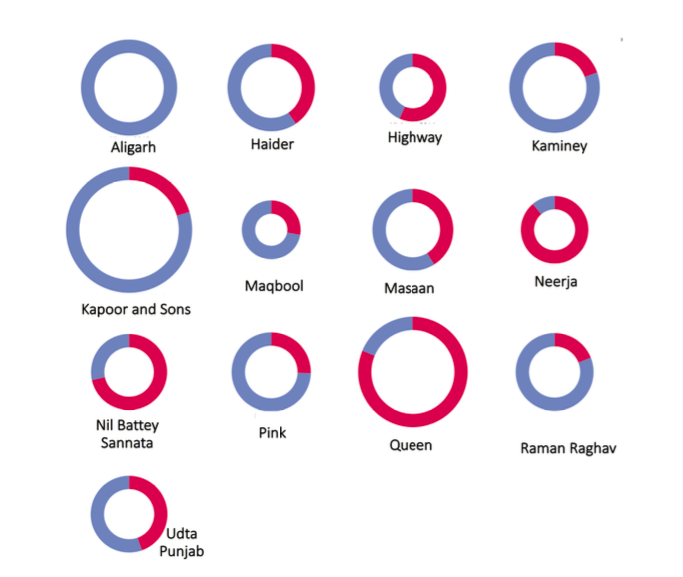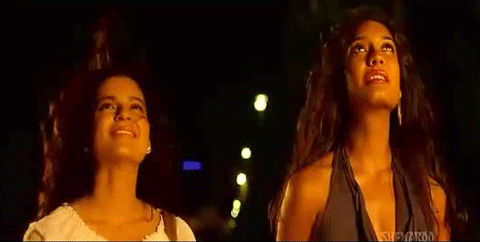Rang de Basanti (2006), which linked India's past struggle against British colonialism to India's present struggle against corruption, attracted global attention, sparked protests, and created a moment of social engagement among young people referred to as the Rang de Basanti effect.
But after my first viewing, I didn’t see the appeal of a time-jumping melodrama that didn't star David Tennant. As an American on my couch during the Obama Administration I was much more interested in looking forward. Things were getting better, obviously- why look to the past? Then election day 2016 rolled around, so I watched Rang de Basanti again, figuring I would suddenly see this film for the inspiring political drama it was received as in India back in 2006. Spoiler alert: I didn't.
Rang de Basanti opens to a tinted film reel, seemingly yellowed with age, in which various young men are performing their morning rituals inside their jail cells. Within moments it become apparent that they are preparing for their own imminent deaths at the hands of the colonial government. The British officer (Steven Mackintosh) assigned to oversee their execution expresses, in voice-over, his sadness that these brave young are going to be hanged, but the youths remain defiant. And then they are killed.
Flash forward to London, 2006, where Sue (Alice Patten) is seeking to make a documentary about the freedom fighters, whose story she reads in the diary of her grandfather, coincidentally the officer who oversaw the executions. Sue is blindsided when two executives tell her the project has been cut because the story won't sell. Sue storms out, demonstrates her appallingly accented Hindi (which will plague the viewer for the remainder of the film) and moves to India to make the documentary on her own.
In India she meets a group of disaffected young men through her colleague Sonia (Soha Ali Khan), whom she recruits to act in her documentary, which is turning out to be more of a docudrama. Represented are members of many of India's largest communities- Muslim Aslam Khan (Kunal Kapoor), Hindu Sukhi (Sharman Joshi), a roguish Sikh (Aamir Khan), as well as Hindu fundamentalist Laxman Pandey (Atul Kulkarni), Karan R. Singhania (Siddharth), Sonia's fighter pilot fiance Ajay Singh Rathod (R. Madhavan), and Ajay's mother Mrs. Rathod, who is portrayed by the elegant Waheeda Rehman in a rare and affecting break from retirement.
When Ajay is killed as the result of faulty plane parts- corruption kills- the team protests Ajay's death and the deaths of other fighter pilots who died under similar circumstances. The protest turns bloody when the police arrive, and the friends are spurred to taking direct action, inspired by their freedom-fighter characters in the documentary. The film weaves the lives of the past and present-day patriots together with near-perfect symmetry.
When I first watched this film I believed that the past is never reflected in the present with the symmetry Rang de Basanti suggests. But on June 26, 2018 the the Supreme Court of the United States rejected the 1944 Korematsu v. United States decision on Executive Order 9066, which justified the internment of Japanese-American men, women, and children with the help of the U.S. Census bureau- in the decision to uphold Executive Order 9645 in Trump v. Hawaii. An injustice of the past passed the torch to an injustice of today, as corruption kills Ajay in Rang de Basanti as surely as the Raj killed young men in colonial India. Clearly the past repeats itself with minimal variation to the theme, and with a large dose of irony: the cherry blossoms that light up my morning commute every spring were from the 1912 gift of 3,000 cherry trees from Mayor Yukio Ozaki of Tokyo to the city of Washington, DC. Those same cherry trees now decorate the memorial to interred Japanese-Americans. Ajay is killed by the government elected by his countrymen just as surely as if he had been killed by a foreign power, but now his government calls it freedom.
In this symmetry the odd character out is Sue, who is annoying in the way that all white women in Bollywood films are annoying. I have never, ever understood the need to include Sue in this film- her role could have just as easily been assigned to a South Asian woman who found an old diary. For a patriotic film, it sure seems to have a white-savior complex. And Rang de Basanti is a spectacularly patriotic film- and it manages to be patriotic without being jingoistic, which is something neither the current nationalist, Islamophobic, xenophobic leaders of the U.S. nor India understand or appreciate.
The challenge is that the patriotism of the film, in both the contemporary and black-and-white scenes, elides the complications of history. The progressive movement in the U.S. has frequently struggled to link past struggles to the present day, and I suspect the exclusionary and incomplete nature of prior progressive movements lies at the root of the left's disconnect from history- issues that Rang de Basanti glosses over with a few words and touching scenes. Complications do not lend themselves to rousing musical montages, and Rang de Basanti is more than willing to gloss over historical differences and tie everything up neatly with a bow- quickly- and call it patriotism.
Is Rang de Basanti cynical or naive? Debatable. Is it over the top? Oh yes. Is it far too clean and clear-cut to reflect the messiness of social change? You better believe it. Does it do a service to the people who are fighting for an equality that wont come about over the course of a single conversation? Nope. I still dont think its a particularly good film. But it is a far more interesting film than I believed it to be on first viewing.
Film: Rang de Basanti (2006)
Director: Rakeysh Omprakash Mehra
Writers: Prasoon Joshi, Rensil D'Silva
Runtime: 157 minutes
Country: India
Language: Hindi, Punjabi, English
But after my first viewing, I didn’t see the appeal of a time-jumping melodrama that didn't star David Tennant. As an American on my couch during the Obama Administration I was much more interested in looking forward. Things were getting better, obviously- why look to the past? Then election day 2016 rolled around, so I watched Rang de Basanti again, figuring I would suddenly see this film for the inspiring political drama it was received as in India back in 2006. Spoiler alert: I didn't.

|
| Capitol Dome and Cherry Blossoms |
Flash forward to London, 2006, where Sue (Alice Patten) is seeking to make a documentary about the freedom fighters, whose story she reads in the diary of her grandfather, coincidentally the officer who oversaw the executions. Sue is blindsided when two executives tell her the project has been cut because the story won't sell. Sue storms out, demonstrates her appallingly accented Hindi (which will plague the viewer for the remainder of the film) and moves to India to make the documentary on her own.
In India she meets a group of disaffected young men through her colleague Sonia (Soha Ali Khan), whom she recruits to act in her documentary, which is turning out to be more of a docudrama. Represented are members of many of India's largest communities- Muslim Aslam Khan (Kunal Kapoor), Hindu Sukhi (Sharman Joshi), a roguish Sikh (Aamir Khan), as well as Hindu fundamentalist Laxman Pandey (Atul Kulkarni), Karan R. Singhania (Siddharth), Sonia's fighter pilot fiance Ajay Singh Rathod (R. Madhavan), and Ajay's mother Mrs. Rathod, who is portrayed by the elegant Waheeda Rehman in a rare and affecting break from retirement.
When Ajay is killed as the result of faulty plane parts- corruption kills- the team protests Ajay's death and the deaths of other fighter pilots who died under similar circumstances. The protest turns bloody when the police arrive, and the friends are spurred to taking direct action, inspired by their freedom-fighter characters in the documentary. The film weaves the lives of the past and present-day patriots together with near-perfect symmetry.
When I first watched this film I believed that the past is never reflected in the present with the symmetry Rang de Basanti suggests. But on June 26, 2018 the the Supreme Court of the United States rejected the 1944 Korematsu v. United States decision on Executive Order 9066, which justified the internment of Japanese-American men, women, and children with the help of the U.S. Census bureau- in the decision to uphold Executive Order 9645 in Trump v. Hawaii. An injustice of the past passed the torch to an injustice of today, as corruption kills Ajay in Rang de Basanti as surely as the Raj killed young men in colonial India. Clearly the past repeats itself with minimal variation to the theme, and with a large dose of irony: the cherry blossoms that light up my morning commute every spring were from the 1912 gift of 3,000 cherry trees from Mayor Yukio Ozaki of Tokyo to the city of Washington, DC. Those same cherry trees now decorate the memorial to interred Japanese-Americans. Ajay is killed by the government elected by his countrymen just as surely as if he had been killed by a foreign power, but now his government calls it freedom.
In this symmetry the odd character out is Sue, who is annoying in the way that all white women in Bollywood films are annoying. I have never, ever understood the need to include Sue in this film- her role could have just as easily been assigned to a South Asian woman who found an old diary. For a patriotic film, it sure seems to have a white-savior complex. And Rang de Basanti is a spectacularly patriotic film- and it manages to be patriotic without being jingoistic, which is something neither the current nationalist, Islamophobic, xenophobic leaders of the U.S. nor India understand or appreciate.

|
| No Ban SCOTUS Baltimore Rally |
The thing is, it works. The final scenes, which inter-cut the freedom fighters past and present, make it clear that the fight is the same, that the evil they face is similarly clear-cut, all deaths for country are equally worthy, and everyone is equally invested in a single outcome- a better version of contemporary India- history be damned. It makes for rousing viewing, and it is this straightforward call to action that spurred the activists so inspired by this film.
And so a film which argues that the ends justify the means works both on the level of story and on the level of history. Is is worth spurring people to progressive action by glossing over difficult history? Is it sustainable? What ends justify what means, and who benefits from the outcome? Rang de Basanti takes the answers as foregone, simple, sunny conclusions.
Is Rang de Basanti cynical or naive? Debatable. Is it over the top? Oh yes. Is it far too clean and clear-cut to reflect the messiness of social change? You better believe it. Does it do a service to the people who are fighting for an equality that wont come about over the course of a single conversation? Nope. I still dont think its a particularly good film. But it is a far more interesting film than I believed it to be on first viewing.
Film: Rang de Basanti (2006)
Director: Rakeysh Omprakash Mehra
Writers: Prasoon Joshi, Rensil D'Silva
Runtime: 157 minutes
Country: India
Language: Hindi, Punjabi, English
×
![]()




















